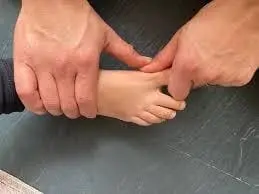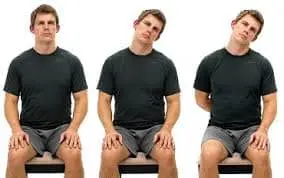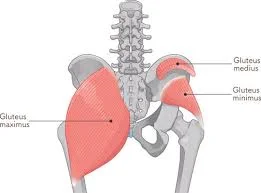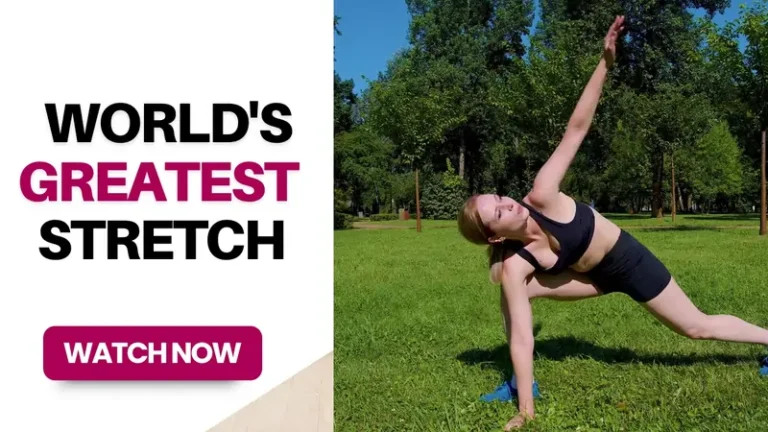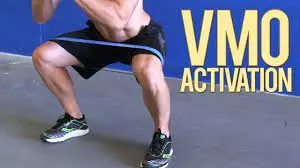14 Best Exercise for Hallux Valgus
Introduction:
Exercise for Hallux Valgus is an excellent alternative, as is wearing properly fitted shoes, using orthotic devices to support the foot, and using pain medicines.
Your toes’ range of motion will improve with physical therapy exercises. The big toe of the foot is frequently tight in people with hallux valgus, so increasing foot mobility is highly beneficial for this condition. Stretches should be held for 30 to 60 seconds in between each exercise, and they should be performed three times. The affected foot’s tight muscles become more flexible due to the stretching exercise.
Causes:
- Rheumatoid arthritis
- A foot abnormalities
- Injury to the foot
- Putting on high heels or tight shoes
Signs and symptoms:
- Inflammation of joints
- An obvious lump at the big toe’s side.
- The bunion’s initial pain and discomfort when wearing shoes
- Deformity of the pronated foot
- Hallux abductor muscle weakness
- Persistent or recurrent pain. You may experience pain when you walk, bear weight on your foot, or try to move the affected foot. Sometimes you may even have pain when your foot is inactive.
- A reduced range of motion.
Risk factor:
- A history of Hallux valgus in the family
- Problems of the inherent foot structure, such as flat feet.
- Injury to the feet.
- Inflammation-producing conditions, like rheumatoid arthritis.
Before starting an exercise program, keep these safety precautions in mind:
It is crucial to optimize the benefits and take a few safety precautions before beginning any exercise program. To determine which exercises are best for your particular issue, speak with your doctor or physical therapist. It’s important to be aware of your body and not push yourself when it hurts. While some pain is a typical after-effect of exercise, Severe or ongoing pain may be a sign of overtraining.
Repetitive injury prevention requires maintaining correct form and technique. If you’re unsure how to complete an exercise program correctly, consider getting medical advice. Your joints and muscles will get more prepared for the exercise if you warm up before it.
Exercise for Hallux Valgus:
Toe splay
- Sit in a chair with your feet firmly planted on the floor, and your back straight.
- As far as you can without getting tired, stretch your toes apart.
- Hold this position for a few seconds.
- Then return to your neutral position.
- Then relax.
- Repeat this exercise five to ten times.
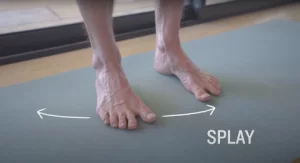
Big toe stretch
- Place your feet on the floor and sit up straight in a chair.
- Place the left foot into the right leg.
- With your fingers, gently extend the big toe up, down, and to the side.
- Use the big toe to hold each position for a short while.
- Then return to your neutral position.
- Then relax.
- Repeat this exercise five to ten times.
- On your second foot, repeat the movement.
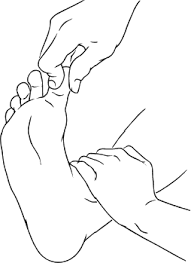
Foam foot roller
- In a chair, take a straight seat.
- Lay the vibrating foam roller with both feet comfortably resting on top of it.
- Locate and push a trigger spot on the feet.
- Hold on for a few seconds.
- You can locate additional trigger locations to hold by rolling the feet back and forth.
- Then return to your neutral position.
- Then relax.
- Repeat this exercise five to ten times.
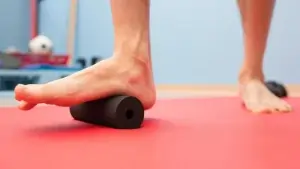
Standing Heel Raises
- Take a few deep breaths and stand comfortably on the ground.
- Take a chair if you need support.
- Place the majority of your weight on the outside of your feet and elevate your heels.
- Hold this position for a few seconds.
- Lower your heels.
- Then return to your neutral position.
- Then relax.
- Repeat this exercise five to ten times.
Figure eight rotation
- The Figure eight rotation exercise is rather straightforward for this condition, much like the toe curl exercise.
- Simply move your big toe in the shape of an eight, not a circle, and complete the task.
- It increases the range of motion and flexibility of the big toe muscles.
- Then return to your neutral position.
- Then relax.
- Repeat this exercise five to ten times.
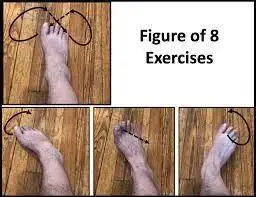
Ankle pump
- This causes your toe joints to move, which reduces stiffness.
- Sit on the ground or in bed.
- 10 clockwise rotations of the foot should be done first.
- After finishing it, draw 10 more circles in the opposite direction.
- Then return to your neutral position.
- Then relax.
- Repeat this exercise five to ten times.
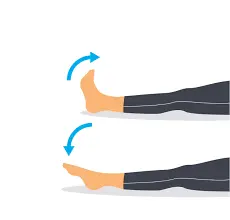
Toe raise, point, and curl
- Put your feet flat on the ground then grab a seat right away as you can.
- Toes should remain on the ground, but heels should be raised.
- Come to a stop when your feet are only slightly off the ground.
- Before releasing the heels, hold them in place for five seconds.
- The second stage should just involve the tips of the big and second toes touching the ground.
- Lift your heels and flex your toes to do this.
- Hold down for five seconds, then release.
- Lift your heels and bring them in during the third stage to ensure that just the tips of your toes are in contact with the ground.
- Hold this posture for five seconds.
- Then return to your neutral position.
- Then relax.
- Repeat this exercise five to ten times.
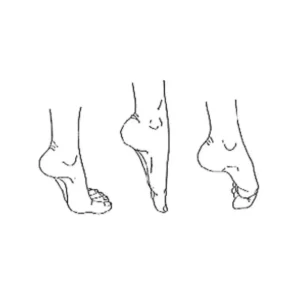
Ankle-Inversion-And-Eversion
For eversion,
- Start this exercise with your affected foot down on the ground.
- Then, move the tips of your toes and the outside of your foot, and then take a step back to your initial position.
- To prevent overreacting, make sure that your leg action differs from that of your foot and ankle.
- Then return to your neutral position.
- Then relax.
- Repeat this exercise five to ten times.
For inversion,
- Starting with your feet in the same position, move the inside edge of your foot toward your body’s midline to complete the ankle inversion.
- Then move them once again.
- Then return to your neutral position.
- Then relax.
- Repeat this exercise five to ten times.
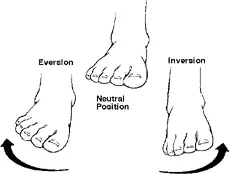
Marble pickup
- For this practice, you’ll need ten to twenty marbles and a bowl.
- Keep the bowl close at hand and place the marbles on the floor.
- Settle in with your feet facing the closest to the ground.
- You should place each stone in a bowl after picking it up with your toes.
- Verify that your big toe is firmly surrounding the marble.
- Then return to your neutral posture.
- Then relax.
- Repeat this exercise five to ten times.
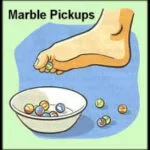
Alphabet wright
- Locate a comfortable place to stand or sit.
- Starting with the capital letters, raise your foot a few inches and write the alphabet in the air with your big toe.
- Make long, downward strokes.
- Proceed to write lowercase characters after you have completed writing the entire alphabet.
- Then return to your neutral posture.
- Then relax.
- Repeat this exercise five to ten times.
Towel curl
- Sit down after firmly placing your feet on the ground.
- Maintain a straight body posture with your legs and feet, and point your toes forward.
- Raise one foot, place it, and then press your heel.
- Over your front, place a towel.
- Your heel needs to be straight on the towel ends.
- Make contact with the towel by extending your toes with both your center and side feet, as much as is practical.
- Pull the cloth toward you while maintaining contact with your toes.
- Try your best to completely secure the arch’s base.
- There will be some towel movement each time you pull back and straighten your foot.
- Then return to your neutral position.
- Then relax.
- Repeat this exercise five to ten times.

Abduction of Toe (using Exercise Band)
- This stretch works the great toe adductor with the help of a band.
- Put a band on each foot, allowing it to pass through the big and second toes.
- Just give in to the band’s pull on your big toe, which will drag it outward.
- Rotate your feet outward slowly to strengthen the band’s pull on your big toe into abduction.
- Hold this position for a few seconds.
- Then return to your neutral position.
- Then relax.
- Repeat this exercise five to ten times.
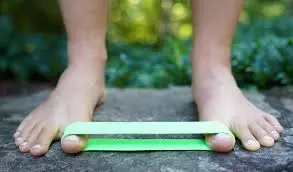
Ankle circle
- Start with a relaxing seating position on the ground.
- It is advised to rotate your ankle ten gentle clockwise and counterclockwise revolutions.
- Make sure you are not moving your full leg as you move your foot and ankle.
- Try circling the letters with your big toe to change up the stretch.
- Then return to your neutral position.
- Then relax.
- Repeat this exercise five to ten times.
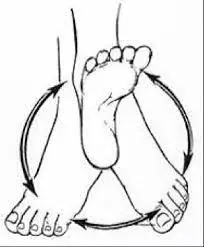
Sand walking
- Look out for any sandy place you can find, such as a beach, a desert, or a volleyball court.
- Take off your shoes and socks.
- Take as many walks as possible.
- Attempt to increase the distance gradually so as not to overstress the muscles in your feet and calves.
- Then relax.
- Walks lasting between ten and twenty minutes at least.

What safety measures need to be followed when working out?
- Before and after your exercises, always warm up and stretch.
- Take care to keep your posture straight while exercising.
- For the greatest training experience possible, dress comfortably and loosely to encourage relaxation and full range of motion. Keep your outfits from becoming overly fashionable or tight.
- When exercising, try not to use any abrupt or powerful movements.
- Avoid doing challenging activities.
- Take a break in between exercises.
- Make slow, gentle bends and stretches.
- Stretches should be done according to the protocol, both before and after sets, and for the prescribed number of repetitions for each exercise.
- You should always stretch the stiff muscles in your joints, even though it could be difficult. Because it is unhealthy and aggravates your sickness, exercise and stretching shouldn’t pain or make you feel as though someone is stabbing you.
- Stop exercising right away if the pain gets worse.
When are you going to stop working out?
- High fever
- Exercise should be stopped if it hurts.
- Severe burning in the muscles.
- You don’t feel good.
- If numbness or discomfort are present.
- Headache
When to visit a physician:
- It might be time to contact a doctor if at-home cures aren’t working for you. If non-surgical treatments aren’t working, they may help you determine if surgery is a suitable alternative.
- Pain relief is surgery’s primary objective. To limit the likelihood of a recurrence and allow you to resume your favorite activities, surgical procedures also try to get back the normal functioning of the toe.
- Many surgical techniques can be carried out by surgeons to return the toe to its normal position.
Prevention:
- Wearing correctly fitting shoes is essential to preventing the worsening of hallux valgus or a case that already exists.
- Your physician may be able to offer advice on how to select the correct shoes.
- Generally, you want to buy shoes with soft soles and a wide toe area.
- Stay away from shoes with narrow, sharp tips and high heels that strain the front of the foot.
- Custom-fitted orthotics can help prevent or slow the development of hallux valgus syndrome if you have flat feet or another genetic structural foot issue.
Summary:
The big toe deformity known as hallux valgus, or simply a bunion, affects many people. The big toe turns inward toward the second toe in this condition, occasionally keeping it. The problem is shaped and appears bumpy as a result of the metatarsal head being more noticeable. When the big toe rubs against shoes, the lump on the side of the toe is frequently red and painful. This is a common foot condition that hurts and is painful. Your gait, balance, and capacity to wear particular shoe styles may all be impacted.
Your big toe needs to be positioned correctly to deal with the hallux valgus issue, so begin therapy with an orthosis like a night splint. These orthoses or shoe inserts will help you maintain a good big-toe posture all the time.
FAQ:
Which muscles are involved in hallux valgus?
In addition to congenital conditions, incorrect footwear and walking with your feet turned outward can contribute to the development of hallux valgus. The adducter and abducter hallucis are the main muscles that cause the hallux valgus.
Does ice help with the hallux valgus?
Applying an ice pack to the affected area is advised by several specialists. Don’t wear shoes with pointy toes or high heels; instead, choose the right footwear. Specialized orthotic devices are recommended by several surgeons to alleviate pain and inflammation. Place pads over the area.
Is it possible to treat hallux valgus with exercise?
Exercise and relaxation can both help you maintain the proper foot posture. An even greater state of hallux valgus can be achieved with strength training of the foot muscles. Exercises like marble pick-ups, toe curls, and active or passive foot movement can be beneficial. Exercise could be a useful remedy for the hallux valgus issue. Your feet might become more mobile with exercise.
Does Hallux valgus have a hereditary or genetic basis?
An anatomical malformation of the foot, hallux valgus is generally inherited from birth.
Which treatment for Hallux valgus works most suitable?
Surgery to correct the bunion is the only practical remedy in this specific instance for treating hallux vagus pain and preventing issues in the metatarsophalangeal joint.
Which at-home treatment for Hallux valgus works best?
The muscles surrounding the big toe can be strengthened and more flexible with basic workouts including toe circles, flexing, and contracting. Furthermore, placing ice packs in the bunion for ten to fifteen minutes several times a day might help ease pain and minimize swelling.
References:
- Bunion/hallux valgus exercise – Epitact, n.d. hallux valgus exercises on https://epitact.co.uk
- July 20, Prajapati, D. (2023b). The 18 exercises in Samarpan Physio’s lists are for hallux valgus. Clinic for Physiotherapy. https://samarpanphysioclinic.com/18-hallux-valgus-exercise-best/
- S. Lindberg (July 9, 2019). 10 simple workouts that can both prevent and treat bunions in your feet We line. Union Exercises: https://www.healthline.com/health/
- Physio (S.) n.d.-c. Top 5 Activities for a Bunion Exercise – Surrey Physio. At Surrey Physio. The following are the top five bunion exercises: The top five. https://www.surreyphysio.co.uk/
- Image 3, 2023, May 24; Footdoc. Plantar Fasciitis Activities: Stretch to Reduce Heel Pain. Georgia’s Advanced Foot and Ankle Institute. Plantar fasciitis can be effectively treated with these 10 excellent exercises.
- Image 12, September 8, 2023; Nd, R. H. BlackBoard ToeBand Use Instructions. Natural Footwear. The usage of blackboard toe bands can be found at https://naturalfootgear.com/blogs/educational-articles

